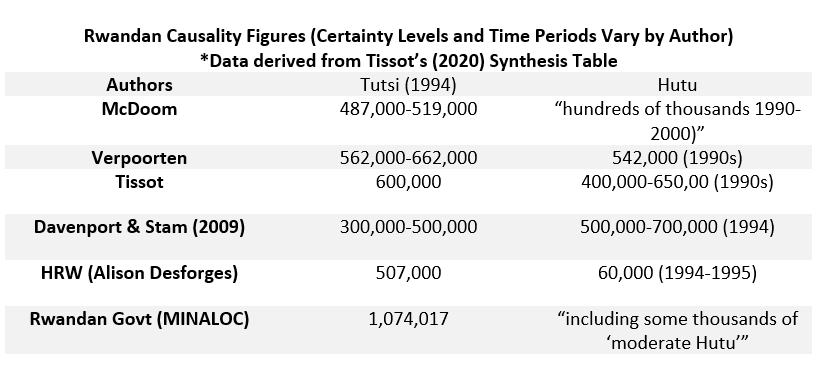“Ever since the Holocaust, in which six million European Jews – among other victims – were deliberately targeted and destroyed, a moral hierarchy of suffering has seized the humanitarian imagination, one in which stories of victimhood are ranked based on the scale of human destruction. Genocide has become a numbers game. In this spectacle of suffering, the bodies of victims literally count” (Meierhenrich 2020, 4).
The figure of 800,000 Rwandan deaths has long been associated with the Rwandan genocide. It has been widely cited in scholarly works, documentaries, museums, and memorials. This casualty figure, while widely cited, is also highly contested. In the most recent edition of the Journal of Genocide Research (2020), this figure is methodologically deconstructed and debated. While the figures modeled in the journal are also contested by scholars, the debates surrounding the politics of numbers raise important questions and concerns about how victimhood is constructed in the wake of genocide and mass atrocity.
As the above quote alludes to, the numbers debate is political in nature. While sociologists, political scientists, demographers, and economists attempt to arrive at casualty figures for the Rwandan genocide, Jens Meierhenrich argues that this debate is inherently imbued with morality and claims of victimhood. This is because, within violent conflicts such as war and genocide, there is a propensity to equate the group with the highest number of victims with true victimhood.
Calculating Casualty Figures
Before diving into the various numerical conclusions of the authors featured in the debate, it is crucial to recognize that these numbers are highly subjective and reflect the myriad of statistical modelling decisions that must be made when deriving these figures.
All of the authors point to the problematic nature of trying to derive a precise estimate of casualty figures based on the existing data. One of the first hurdles for scholars is calculating a pre-genocide baseline, in which they determine the population of Rwanda as a whole, as well as its racial breakdown.
For example, McDoom (2020) argues that precise figures are impossible for a few reasons. First, the existing data scholars used to derive these numbers, such as census data and population growth models, are faulty. In the period leading up to the Rwandan genocide, censuses underreported the number of Tutsis in Rwanda, in an effort to justify the ethnic quotas that had been put in place by the Habyarimana regime. Tutsis may have also self-reported as Hutu in an effort to avoid discrimination. Furthermore, as Armstrong and his co-authors (2020) explain, many arbitrary decisions must be made in the process of modeling causality, and scholars must place a significant amount of credibility and faith in the aforementioned existing data.

The above chart summarizes the key authors in this debate who have modeled their own casualty figures. It is important to note, however, that several others have weighed into this debate providing feedback on the above numbers and the various methodological approaches. This chart also includes the highly contested numbers of Davenport & Stam (2009), the oft-cited Human Rights Watch Report, and the Rwandan Ministry of Local Affairs’ own numbers (found at memorial cites across the country).
There are a few points worth stressing in this table. First, the majority of estimates regarding Tutsi deaths during the 1994 genocide are around 500,000, with the Rwandan government’s own reporting being an outlier. Interestingly, however, is the vast array of casualty figures of Hutus, ranging from 60,000 to 700,000. It is also important to note that many of these casualty figures are derived from not only direct killings of Hutus, but also Hutu deaths as a result of disease and access to resources. This is a result of living in refugee camps in the immediate aftermath of the genocide.

Why does this debate matter, and should it?
It is apparent that many of the scholars in this journal point to increased numbers of Hutu deaths. Thus, if the number of fatalities between Tutsi and Hutus is much closer than initially believed, the Rwandan government’s claims of exclusive Tutsi victimhood stand to be challenged. And, if these higher Hutu casualty figures are accurate than perhaps we need to focus on the structure of genocide, highlighting how it occurred within the context of a civil war.
This raises some important questions. For example, as McDoom asks: “Should the killing of Hutu be seen as morally less reprehensible or equivalent?” (2020, 84). And should Hutu victimhood be acknowledged? McDoom argues that recognizing Hutu casualty figures matters for three reasons: it shapes the categorization of violence, it raises questions of the experience of memory and justice following the genocide, and it has implications of reconciliation. As previous scholars have noted (Berry 2018), recognition of a group’s victim status often transfers into distinct political advantages and economic resources. Additionally, by acknowledging Hutu casualty figures, it complicates current perceptions of Hutus as the sole perpetrators and Tutsis as the sole victims of violence. It may go as far to imply that following (or during) the 1994 Genocide against Tutsi, a politicide against Hutus may have also occurred, in which Hutus were targeted for their political beliefs, rather than for their ethnic identity. At it’s very least, however, discrepancies in the numerical figures and identities of victims warrants question the validity of the oft-cited 800,000 casualty figure.

Comments